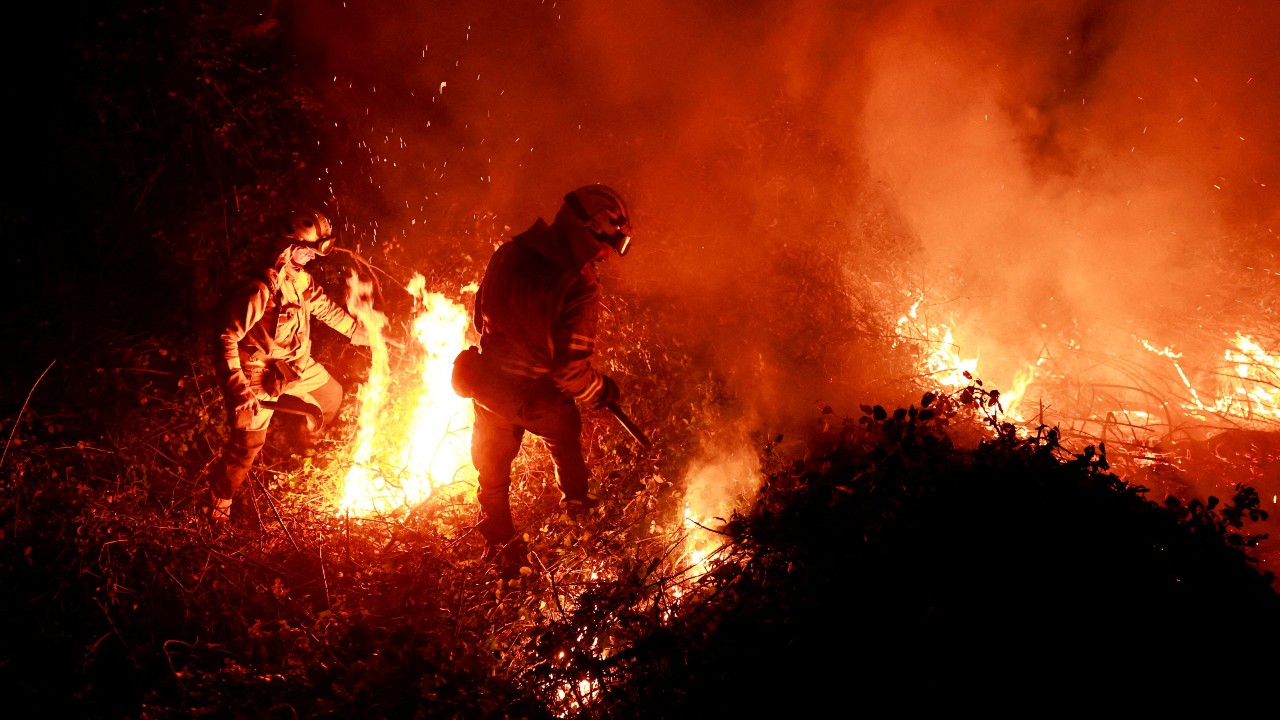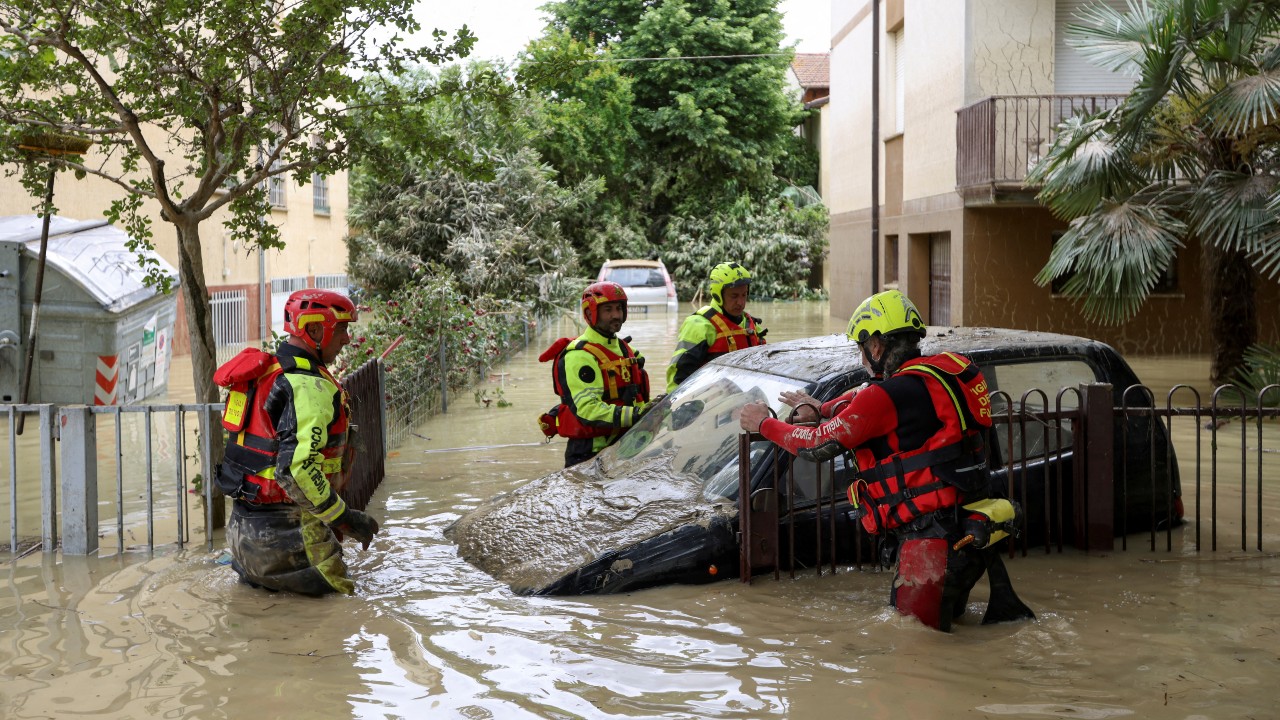
Firefighters tackle a forest fire after prolonged drought and a heatwave in Asturias, Spain, March 2023. /Vincent West/Reuters
Firefighters tackle a forest fire after prolonged drought and a heatwave in Asturias, Spain, March 2023. /Vincent West/Reuters
Extreme weather conditions in Europe have killed almost 195,000 people and caused economic losses of more than $600 billion since 1980, the European Environment Agency said Wednesday.
"Nearly 195,000 fatalities have been caused by floods, storms, heat- and coldwaves, forest fires and landslides" between 1980 and 2021, the EU agency said in its report.
Of the $605 billion in losses, only $180 billion, or 30 percent, were insured, the EEA said, as it launched a new online portal collating recent data on the impact of extreme weather.
"To prevent further losses, we need to urgently move from responding to extreme weather events...to proactively preparing for them," said EEA expert Aleksandra Kazmierczak.
According to the latest data, heatwaves accounted for 81 percent of deaths and 15 percent of financial losses. Europe needs to take measures to protect its aging population, with the elderly particularly sensitive to extreme heat, the EEA said.
"Most national adaptation policies and health strategies recognise the impacts of heat on cardiovascular and respiratory systems," it said. "But less than half cover direct impacts of heat like dehydration or heat stroke."
READ MORE
New heatwave hits France during worst-ever drought
Why it's so hot – and why we have to adapt to it
After historic floods, German towns still fragile
The summer of 2022 saw more deaths than usual in Europe following repeated heatwaves, but the 2022 deaths were not included in the data published on Wednesday.
There were 53,000 more deaths in July 2022 than the monthly average in 2016-2019, up by 16 percent, though not all of those deaths were directly attributed to the heat, the EEA said. Spain registered more than 4,600 deaths linked to the extreme heat in June, July and August.
Climate modeling has predicted longer, more intense and more frequent heatwaves. In February 2022, the EAA said extreme weather killed 142,000 people and caused $550 billion in losses for the period 1980-2020. The increase in the figures released on Wednesday was partly due to the fact that in 2021, flooding in Germany and Belgium led to economic losses of around $50 billion.
In terms of deaths, a change in methodology in France and Germany was responsible for the large variation, the EEA said.
'Devastating consequences'
Climate change caused by humans increased the risk of drought five- or six-fold in 2022, a year when forest fires ravaged twice as much territory as in recent years, the EEA said.
Droughts could end up being very costly. Economic losses could rise from around $9 billion per year currently to $27 billion at the end of the century if the planet warms by 1.5C degrees Celsius. That could climb to $33 billion if it warms by 2C and $48 billion if it warms by 3C, according to scientific scenarios.

Firefighters find a flooded car after heavy rains hit Italy's Emilia-Romagna region in May 2023. /Claudia Greco/Reuters
Firefighters find a flooded car after heavy rains hit Italy's Emilia-Romagna region in May 2023. /Claudia Greco/Reuters
The consequences for agriculture could be "devastating," the EEA warned. "Farmers can limit adverse impacts of rising temperature and droughts by adapting crop varieties, changing sowing dates and with changed irrigation patterns," the report said, adding that without changes, yields and farm incomes are projected to decline in the future.
While human losses from flooding are much lower, accounting for just two percent of the total, they are the most costly, accounting for 56 percent of economic losses.
Schools and hospitals in 'heat islands'
The report also warned that nearly half of schools and hospitals in European cities are located in urban "heat islands" – exposing vulnerable populations to health-threatening temperatures as climate change impacts worsen.
Around 46 percent of hospitals and 43 percent of schools are in areas at least 2 degrees Celsius warmer than the regional average – fuelling fiercer heatwave impacts than in rural areas.
The reason is the urban heat island effect, where dense clusters of buildings and infrastructure like roads absorb and retain more heat than green areas.
"This is something which will have severe consequences for human health," said Blaz Kurnik, head of the EEA's climate adaptation department, again warning of the effects on the vulnerable.
"Vulnerability in Europe is also increasing due to the aging population, due to the more condensed cities," Kurnik said. "This is something that, with the combination of the heat waves, will become quite a risk for society in the future."
The phenomenon has already been observed during temperature extremes. During an August 2003 heatwave, heat-related mortality in cities in the West Midlands area of Britain was twice as high as in local rural areas.
The EEA urged governments to introduce measures to lessen the heat island effect in cities, such as introducing more cooling green spaces and water. Some already are – such as the city of Paris's program to transform 10 pilot schools' grounds into cooler, greener spaces, with fountains and drought-resistant plants.
Kurnik said other measures could include bringing forward the start of school holidays to avoid teaching in intense heat – but that in general, while all EU countries now have some form of climate adaptation strategy, most have yet to turn them into concrete actions.

Subscribe to Storyboard: A weekly newsletter bringing you the best of CGTN every Friday
Source(s): Reuters
,AFP